It’s summer and T-shirts reign. Everywhere you look there is a sea of crewneck, shapeless, dreary-colored T-shirts. How did they get to be a staple in so many people’s wardrobes? I keep hoping I’ll wake up and realize it was all a bad dream but no such luck!
So, what is the origin of the T-shirt? I found this at (http://en.wikipedia.org/wiki/T-shirt):
“The T-shirt evolved from undergarments used in the 19th century, through cutting the one-piece “union suit” underwear into separate top and bottom garments, with the top long enough to tuck under the waistband of the bottoms. T-shirts, with and without buttons, were adopted by miners and stevedores during the late 1800s as a convenient covering for hot environments.
“T-shirts, as a slip on garment without buttons, originally became popular in the United States when they were issued by the U.S. Navy during or following the Spanish American War. These were a crew-necked, short-sleeved, white cotton undershirt to be worn under a uniform. It became common for sailors and Marines in work parties, the early submarines, and tropical climates to remove their uniform “jacket”, wearing (and soiling) only the undershirt. It is possible that the Navy uniform boards first discovered the T-shirt by watching dock crews.”
They, of course, got their name because of the shape of the shirt, a “T” (which, right there tells you it’s shapeless). Because they are so universally loved, they are touted as being versatile and basic, and to be honest, they are neither. Shocked? Let me explain:
Your average shapeless T-shirt (with or without logos!) is universally unflattering, especially for most women who, surprise, have a shape! This is because:
- While women with a long neck and who are small busted might look acceptable (notice I didn’t say great!) in a crew neck, it is generally not anyone’s go-to neckline. That tells you something. Why settle?
- The sleeves usually hit at a bad point on the arms and often stick out making your body look wider than it is. Yes, you can have them altered to improve the look, but 99.99% of people don’t and that still doesn’t address all the other issues with them.
- They are boxy and shapeless (which describes exactly how you will look in one), so it does absolutely nothing to flatter your figure (mostly because you can’t see your figure) and it does not (let me repeat that…does not!) make you appear smaller by trying to hide things. In fact, it does just the opposite. Ooops, I suspect that wasn’t your intent!
- The color (if it has one – often they are worn in white or light gray) usually fades within a few washings.
- More and more they are made out of lightweight, flimsy cotton that is very unforgiving (and often much more revealing) so it totally undermines the intended effect of “let’s hide this body.”
So, some manufacturers have tried to update the style to make it more appealing – with mixed results. A few looks to avoid:
- Cap sleeves. An unflattering sleeve length on many women, both from a balance perspective and where they hit on your arm. Janet Wood (co-founder of the Fashion Fit Formula) says, “Non-puff cap sleeves can be successfully worn by teenagers with very toned arms, otherwise you are better off in a sleeveless top or with a short sleeve to your perfect pivotal point.”
- V-neckline. Usually a v-neck is more flattering but T-shirt companies often make the “V” too short so the balance is all wrong.
- Extreme fit. Now, instead of making them too baggy they are making them skin tight which is equally unflattering. Can we have a little balance here, please!
So, yes, T-shirts are cheap and easy, but are they worth it? Important note: Settling for something quick and easy at the expense of your personal satisfaction with how you look usually wears thin after awhile.
When buying a T-shirt, look for:
- Flattering Neckline: Generally a V-neck or Scoop.
- Sleeve Length: A short sleeve that hits below the widest part of your arm and doesn’t stick out, go 3/4 length sleeves, or sleeveless.
- Flattering Fit: Something that skims your body rather than swallowing it up or looking and feeling like it’s glued to you.
- Pattern: If a solid color is not your best look, try a fabulous pattern to distract the eye (it works wonders!).
As I write this I am sitting at my neighborhood café in a pair of comfy white jeans and a fabulous Glima T-shirt (this one, to be exact)
Once again, they are offering my readers a very special coupon (be sure to register on the site before you check out so the coupon code takes effect)!
Go to www.glima.com and use coupon code GINGER to receive the discount!
I look casual, comfortable, pulled together (I have a cute pair of earrings with it), and that’s the look so many women struggle with. Give it a try and make a commitment to yourself to feel good whether you are going to work or running errands. You’ll love how you feel!
(Want help? If this sounds interesting and like just what you need, then please fill out the “I Need Help” form, and we’ll find a time to talk (no charge and no expectation). This can be the first step towards creating a style you LOVE!)


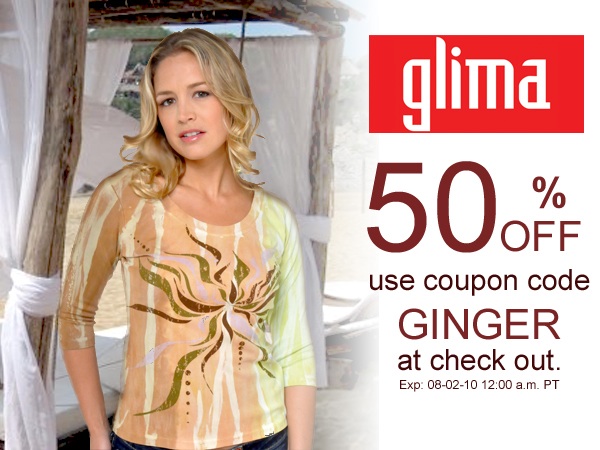
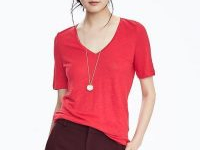
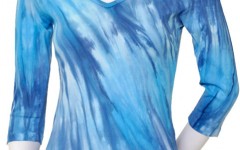
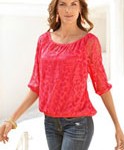
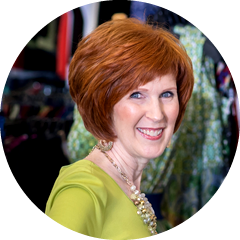
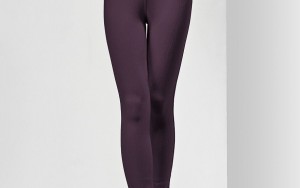

4 Responses
Tee shirts are my friend! Soft cotton against my sensitive skin feels great. When worn as an “undershirt” beneath cashmere and wool sweaters, they keep me from sweating into my “good clothes” and lessen my dry-cleaning bills. Some of them are more jewelneck than crewneck, and look spiffy under a suit jacket (or a leather jacket) with a nice scarf and necklace. And they pack well, wash and dry easily, and are perfect for travel. How can you have a beef against this super staple? If you’re proud of your figure, they highlight it without looking like you tried too hard. If you’re not so sure… they give you a contemporary look without being as revealing as, say, tanks and halters. Unless you are talking about the football-jersey variety here, tee shirts can be a *very* good friend indeed!
You’re right, Hollis, they can be a valuable staple. That said, you have to choose very, very wisely. I have seen an inordinate number of unflattering T-shirts. Worn under things to keep warm or protect your skin is great but when they are worn alone…that’s when the selection is so important. One of your key phrases is “if you’re proud of your figure”…this is where the challenge lies for so many women, especially those over 40. When you gain weight in the middle of your body (as many women who are post-menopausal do), the average T-shirt becomes much less flattering and actually draws focus to that part of your body. As I mentioned in the article, at this point, fabric and cut become absolutely critical. It sounds like you are proud of your figure and that’s wonderful. You can count yourself among the more fortunate. Most of the women I work with are not that lucky and that’s where selection makes all the difference in the world. Every woman deserves to (and can) feel fabulous about the way she looks — I’m so glad you do!
Since I work from home, sometimes the only place I go is Starbucks for 5 minutes to get coffee. This doesn’t lend itself to lots of extra dressing up.
Luckily I now have Glima and a number of their t-shirts. I don’t have to wear the white, gray, or black boxes I was wearing for years, I can have color, a lovely neckline, and something that has shape without showing every bodily detail to the world. I may not need to dress up, but it’s wonderful to be able to put on something with a bit of style that fits so well.
BTW – my pet peeve lately… the t-shirts I see in most stores are paper thin. I hate that! Even on the mannequins in the store they use 2 or 3 layers. What a stupid waste. In the summer no one wants to wear layers. However, if someone is silly or desperate enough to buy one and not layer – the world sees everything… all the the bumps, bulges (and etc) we don’t want or shouldn’t have on display. GAH!
Keep up the evangelizing Ginger! One day you’ll help us all to be heard by the clothing makers. I have faith!
So glad you are enjoying your Glima T-shirts! They are so pretty and comfortable and definitely not paper thin which I am not a fan of as well (as you know from my article). Thanks, too, for having faith. I keep hoping more designers will jump on the bandwagon of beautiful, flattering styles for everyone (hey, remember us baby boomers — we’re a force!) — not just 20-somethings (and even they don’t always look good in some of the styles that are out there!).